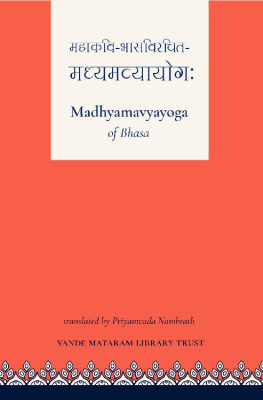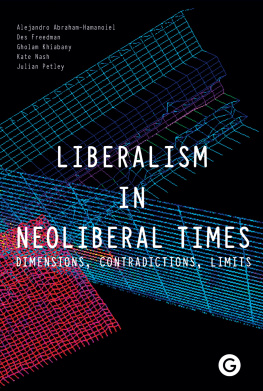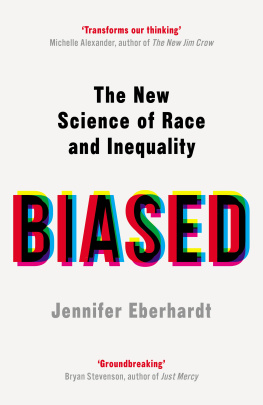:
--
Madhyamavyayoga
Composed by Bhasa
Translated and Annotated by
Priyamvada Nambrath
First Edition
29 March 2018
Published by
Vande Mataram Library Trust
875, Sector 17B, Gurugram, Haryana-122001
Phone: +91 9952888350, +91 124 4361872
Mail:
Cover design by Anjali Nambrath
In the memory of my father
- my constant light
INTRODUCTION
Sanskrit Drama
The Sanskrit term for drama is naa , nya or naka - these words are derived from the root na which itself is a vernacularized derivation from the Sanskrit root nrt , which means to dance. Thus the word itself reveals the ancient origins of drama as being related to secular, public performance whose purpose was to connect with the common people. However, the rules of drama are laid out in the Nyastra of Bharata, and this book has been called the fifth Veda. Here on earth, the earliest reference to a staged play comes from Patajalis Mahbhyam, where mention is made of two plays, Balibandham and Kamsavadham. These references point to dramas close connection with religion, and this is further borne out by references in the Veda to music and dance performances during religious events. The Vedas themselves record events in the form of dialogues, and incorporate gesture and intonation in their own recitation. The Mahbhrata and Rmyaa were initially popular as performances by singing bards who must also have incorporated some dramatic elements into their routine. Besides these epics which later attained the status of scripture, the earliest dramas we have access to deal not just with the exploits of divine characters, but also with the lives of mortal heroes and ordinary people.
In the Nyastra, Bharata categorizes drama into ten types based on the length, subject matter, characteristics of the leading roles, and the predominant sentiment, or rasa , in the play. This suggests that there must have been a wide range of plays readily available by Bharatas time, but none of these have survived to the present. The earliest plays that we have access to today are the thirteen plays commonly ascribed to Bhsa. The 14 th century Shitya-darpaa of Viwantha, which is one of the most highly regarded works on Alakrastra (the science of poetics), divides plays into rpakas (dramas) and uparpakas (minor dramas), and further divides the first category into ten types, and the second into eighteen. Every play has three components vastu or plot, net or hero, and rasa which is variously (and unsatisfactorily) translated as sentiment, aesthetic relish, aesthetic flavor, and so on. Vastu and net are always subsidiary to rasa , and serve to accomplish the generation of rasa , which is always of primary importance in a play. Nine sentiments, or navarasas , are generally recognized the romantic or rgra , heroic or vra , compassionate or karua , furious or raudra , humorous or hsya , frightful or bhaynaka , disgusting or bbhatsa , wondrous or adbhuta and peaceful or nta .
Sanskrit dramas almost never have an unhappy ending. They do contain grief, fear, anger and suffering, but by the end of the play all these issues have been resolved to everyones satisfaction. The plots are often drawn from Puranic legends, the Rmyaa and the Mahbhrata. Even though both these epics have tragic endings, dramas based on these epics are composed in such a way that they end on a happy and auspicious note. The dramas contain a rich mix of prose and lyric poetry, as characters frequently break into verse to offer a general observation, reflect on a situation, or describe a scene or situation in great detail. The plays also generally feature a mixture of classical Sanskrit and the Prkrit dialect, where Sanskrit is spoken by the royal and the high-born, and Prkrit by all the women and common folk. Stage decorations and props are kept to a minimum, and these are indicated by words and gestures on the part of the actors. There is always a screen that forms a background at the back of the stage, and is used for entry and exit of the characters.
Every play begins with a nnd , a prayer or benediction, which is immediately followed by a prastvan , or prelude. In the prastvan , there is generally a brief introduction to the dramatist and the play. The stradhra , or stage manager, recites the nnd and conducts the prastvan , after which he leaves the stage and turns the performance over to the characters of the play. The end of the play is marked by the bharatavkyam which is a concluding stanza of prayer or blessing.
Bhsa The Playwright
Bhsa is perhaps the most enigmatic of all Sanskrit playwrights. He is more ancient than any other dramatist in Sanskrit, and we know absolutely nothing about his personal history. His dramatic works have received high praise from poetic geniuses like Klidsa and Ba Bhaa. All through the classical period of Sanskrit, gifted literary critics like Rjaekhara, Abhinavagupta, Rmacandra and others have written glowing tributes to him. Even though his verses have been frequently quoted, and some of his plays mentioned by name, somewhere down the ages, all the plays of Bhsa were irretrievably lost. Perhaps the rise of Klidsa and later dramatists eclipsed his fame, or perhaps Bhsa with his incredible generosity of spirit and limitless sympathy for the human condition was just too much of an outlier for a world that had begun to see its classical characters and narratives as fully evolved and completed pieces of an established tradition. Whatever the reason, even as his plays faded into obscurity, Bhsa himself escaped oblivion and lived on in the collective memory of scholars as a poet par excellence.
Since most of the references to Bhsa are by writers from north India, some scholars speculate that the plays were once popular there, and that Bhsa might have lived somewhere in this region. However, no copy of any of his plays has been located in north India thus far. But a set of thirteen plays attributed to Bhsa was finally discovered in the twentieth century in a manuscript library in Trivandrum, a city in southern Kerala in the southernmost tip of India. Copies of the same plays were also discovered in private family collections such as those of the famous Manalikkara Mathom. One of these plays (Svapnavsavadattam) was also independently discovered in Mysore around the same time. This has led some to theorize that Bhsa may actually have been a native of the south. However, the region of Kerala finds no mention in any of Bhsas plays. It is also possible that the plays survived only in the deep south of India, because this region was remote enough to have escaped the pillage and depredations that were the constant ordeals of the north.
T. Gaapati Sstri, the curator of the Trivandrum Manuscripts Library, discovered these thirteen manuscripts in the librarys collection in 1906. At that point, the palm leaf manuscripts were estimated to be about three to four hundred years old, and the script, written in old Malaylam characters, was still entirely legible. These are the works that have come down to us today, although we have no way of knowing if they constitute the entire corpus of Bhsas work. It is entirely possible that Bhsa may have written other plays that still remain missing. Part of the credit for this discovery of the Malaylam manuscripts may also be due to Ayilliam Tirunl, a king of Travancore in the mid-1800s, who was also a Sanskrit research scholar of a high caliber. He is credited with having discovered a manuscript of one of Bhsas most legendary plays, Svapnavsavadattam, and adding it to the palace library. AyilliamTirunl was hardly unique in this regard, for he was descended from a long line of scholarly kings such as Rja Mrta Varma (who rebuilt the Ananda Padmanbhaswm temple in 1730), Rja Rma Varma (a patron and himself a writer of drama) and the peerless Swti Tirunl. This serves as a useful reminder that the royalty of the state of Travancore were not merely rulers, but remarkable intellectuals and scholars as well. Indeed, the plays of Bhsa survived through performance only because they received continuous patronage from the erudite maharajas of Travancore.






